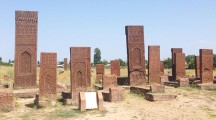Abstract
This paper investigates square Kufic scripts, a type of architectural decorative art in Islamic culture, as a visual pattern. Considerable research has been carried out previously on the subject, treating the square Kufic scripts as text. In contrast, the visual approach of this paper proposes that the pattern generation in Kufic scripts needs to be investigated. The main contribution of this research is presenting a novel algorithm to create square Kufic patterns that can totally cover a planar shape. In traditional definitions, such a pattern is called mushkil (‘complicated’) being special because of the “readability” of both black and white words, by its own criteria. The design principles implemented in the algorithm are adopted from original written sources. Also, some new principles are proposed here to make up for the limited availability of sources. In comparison to other methods, the proposed method is much simpler and more effective in terms of formal analysis and generation.















Similar content being viewed by others
References
Ahuja, Mangho, and A. L. Loeb. 1995. Tessellations in Islamic Calligraphy. Leonardo 28 (1): 41–45.
Allahverdi, R., M. M. Dehshibi, A. Bastanfard, and D. Akbarzadeh. 2012. EigenCoin: Sassanid coins classification based on Bhattacharyya distance. Computer Science 1151.
Arifoglu, Damla, Emre Sahin, Hande Adiguzel, Pinar Duygulu, and Mehmet Kalpakli. 2015. Matching Islamic patterns in Kufic images. Pattern Analysis and Applications 18 (3): 601–617.
Dehshibi, Mohammad Mahdi, Ali Shirmohammadi, and Andrew Adamatzky. 2015. On Growing Persian Words with L-Systems: Visual Modeling of Neyname. International Journal of Image and Graphics 15 (3): 1550011-1–1550011-16.
Fazaeli, Habibollah. 1970. Atlas-e Khat. Esfahan: Anjoman-e Asar-e Melli.
Frishman, Martin, Hasan-Uddin Khan, and Mohammad Al-Asad. 2002. The Mosque: History, Architectural Development & Regional Diversity. Thames & Hudson.
Herr, Christiane M. 2015. Second-order cellular automata to support designing. Kybernetes 44 (8/9): 1251–1261.
Ilachinski, A. 2001. Cellular Automata: A Discrete Universe. New Jersey: World Scientific.
Keshavarzi Miandashti, Hamidreza, and Bahman Fizabi. 2017. Guneshenasi-e khat-e bannai (ma’qeli), bar asas-e shiveie tarahi va raveshhaie ejraei. Honarhaie Sana’ie Iran 47-61.
Lee, Youngjin, and Seung Hyun Kim. 2016. Algorithmic Design Paradigm Utilizing Cellular. Nexus Network Journal 481–503.
Maheronaqsh, Mahmood. 1991. Khat-e Banai. Tehran: Sorush.
Maheronaqsh, Mahmood. 1981. Tarh va ejra-ie naqsh-e kashikari-e Iran. Vol. 4. Tehran: Entesharat-e muse-ie Reza Abbasi.
Minoofam, Seyyed Amir Hadi, and Azam Bastanfard. 2010. Square Kufic Pattern Formation by Asynchronous Cellular Automata. 9th International Conference on Cellular Automata for Research and Industry. Ascoli Piceno: Springer. 79–82.
Minoofam, Seyyed Amir Hadi, Mohammad Mahdi Dehshibi, Azam Bastanfard, and Jamshid Shanbehzadeh. 2014. Pattern Formation Using Cellular Automata and L-Systems: A Case Study in Producing Islamic Patterns. In: Cellular Automata in Image Processing and Geometry, eds. Paul Rosin, Andrew Adamatzky and Xianfang Sun, 233-252. Switzerland: Springer, Cham.
Moustapha, Hoda, and Ramesh Krishnamurti. 2001. Arabic Calligraphy: A Computational Exploration. Mathematics and Design (Deakin University) (1): 294–306.
Sakkal, Mamoun. 2006. Square Kufic Calligraphy in Identity Design. Identity magazine (8): 78–82.
Steeb, W. H. 2005. The nonlinear workbook. Singapore: world scirntific publishing.
Toffoli, Tommaso and Margolus, Norman. 1987. “II.12 The Margolus neighborhood” In Cellular Automata Machines: A New Environment for Modeling, 119-136. Cambridge: MIT Press.
Ulam, S. M. 1962. On Some Mathematical Problems Connected with Patterns of Growth of Figures. Proceedings of Symposia in Applied Mathematics 215-224.
von Neumann, J. 1951. The general and logical theory of automata. Cerebral Mechanisms in Behavior-The Hixson Symposium 1–31.
Zomarshidi, Hossein. 1988. Kashikari-e Iran. Tehran: Keihan.
Zomarshidi, Hossein. 2002. Khotut-e ma’qeli va Bana dar memari-e iran. Tehran: Roshd-enamuzesh-e honar.
Author information
Authors and Affiliations
Corresponding author
Additional information
Publisher's Note
Springer Nature remains neutral with regard to jurisdictional claims in published maps and institutional affiliations.
About this article
Cite this article
Sabetfard, M., Nadimi, H. Generating Square Kufic Patterns Using Cellular Automata. Nexus Netw J 22, 275–290 (2020). https://doi.org/10.1007/s00004-019-00454-3
Published:
Issue Date:
DOI: https://doi.org/10.1007/s00004-019-00454-3




